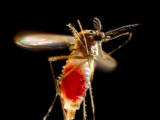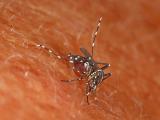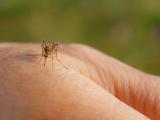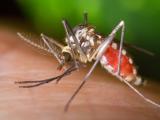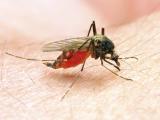Sep 5, 2012 (CIDRAP News) – The number of West Nile virus cases in the United States this year has jumped by about 25% in the past week, and though new reports are still coming in at a record pace, Texas—the hardest hit state—is seeing some promising signs that interventions such as aerial spraying are working.
At a media briefing today, Lyle Petersen, MD, MPH, director of the Centers for Disease Control and Prevention's (CDC) Division of Vector-Borne Infectious Diseases, said the Labor Day holiday may have slowed the flow of reports from states a bit, and health officials could see a bigger jump in WNV cases next week. He added that the CDC is seeing the highest number of cases reported through the first week of September since the disease was first detected in 1999 and that officials expect more new cases will continue to be reported until October.
As of yesterday the CDC had received reports of 1,993 WNV infections this year, up 403 from the previous week. The number of neuroinvasive cases jumped by 180, to 1,069, and 21 more deaths were reported, pushing the nation's total so far this year to 87.
Petersen said more than 70% of cases have been reported by six states, the same as reported last week: Texas, South Dakota, Mississippi, Oklahoma, Louisiana, and Michigan.
The CDC has been consulting with states that were affected by Hurricane Isaac, and though such storms don't typically lead to a sizeable increase in mosquito populations that spread WNV, they can spark an explosive increase in nuisance mosquitoes, he said. States that bore the brunt of the storm have considerable experience handling mosquito problems, and sometimes health officials use aerial spraying to control the nuisance mosquitoes, Petersen said.
David Lakey, MD, commissioner of the Texas Department of State Health Services (TDSHS), said health officials continue to be very concerned about rising numbers of WNV infections in Texas and other states. He said Texas has just surpassed the record numbers of neuroinvasive cases and deaths set in 2003.
At 495, the number of neuroinvasive cases has now topped the 439 reported in 2003, Lakey reported. He said the death toll has risen to 40, equal to the number reported in 2003, though more deaths have occurred and will be reflected shortly when the state updates its total. The total number of cases currently stands at 1,013.
CDC experts are collaborating with state officials to gauge the effectiveness of aerial spraying activities, which have been completed, and so far an analysis of the preliminary data is encouraging, Lakey said. In areas where weather conditions allowed two consecutive treatments, mosquito density dropped 93%, and early data suggest that in areas of north Texas where about half of mosquito pools had previously tested positive for WNV, the percentages of positives were down to around 5% to 6%, he said.
"This is the worst year ever in Texas, but we're starting to see some encouraging signs," Lakey said.
The state is monitoring other hot spots as well, such as Travis County near Austin, where 28% of mosquito pools have tested positive for the virus, he said.
Petersen said it's difficult to tease out why many states are recording high numbers of WNV cases, but hot weather can increase the infectivity of the mosquitoes that transmit the virus. He added that city environments are complex, and even in drought conditions, lawn watering and bird baths can provide enough water to create mosquito breeding sites.
He said vector-borne diseases are among the fastest growing emerging diseases, owing to changes in ecology, population growth, and the movement of animals and people.
See also:
CDC WNV home page
Texas WNV case total
Aug 29 CIDRAP News story
